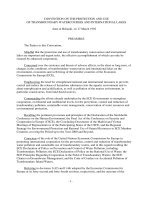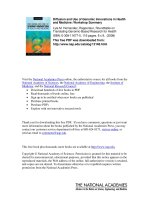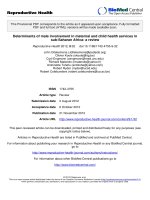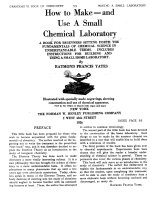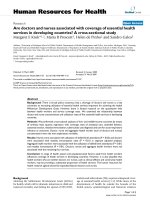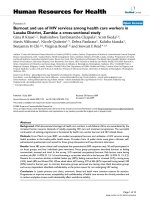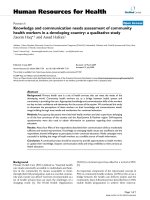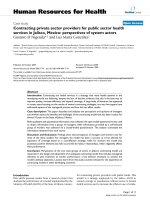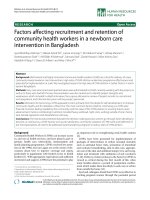Self reported illness and use of health services in a rural district of vietnam findings from an epidemiological field laboratory
Bạn đang xem bản rút gọn của tài liệu. Xem và tải ngay bản đầy đủ của tài liệu tại đây (228.56 KB, 7 trang )
ORIGINAL ARTICLE
Self-reported illness and use of health services in a
rural district of Vietnam: findings from an
epidemiological field laboratory
Kim Bao Giang1 and Peter Allebeck2
1
Department of Health Management and Health Policy, Faculty of Public Health, Hanoi Medical University, Vietnam, 2Department of
Social Medicine, University of Gothenburg, Sweden
Scand J Public Health 2003; 31(Suppl. 62): 52–58
Aims: The aims of the study were to assess the pattern of self-reported illness as well as use of health services in a rural
district in Vietnam, and to analyse these in relation to gender, age, educational level, occupation, and economic status.
Methods: A population-based survey of 11,089 households was conducted in 1999. Through household interviews, data were
collected on self-reported health, use of health services during four weeks prior to the interview, and other background
factors. Results: The prevalence of self-reported illness was 48%. Cough, fever, and headache were the most commonly
reported symptoms (20%) while cardiovascular disorders were least reported (0.6%). Occurrence of illness was significantly
lower in groups with higher education, especially among men, but there was no difference between occupational and
economic groups. Self-treatment was very common (69%). Private health facilities were used to a large extent, while
community health stations played a less important role. Use of district hospitals was significantly higher among employed
people. Discussion: An epidemiological field laboratory enabled analysis of self-reported illness and use of health services,
which is important for planning of health services. We found a high level of reported illness but a very low utilization of
community health services. Better knowledge about illness patterns could be important for improving quality of and access
to community health services.
Key words: epidemiology, health services utilization, self-reported illness, socioeconomic conditions, symptoms.
Kim Bao Giang, Department of Health Management and Health Policy, Faculty of Public Health, Hanoi Medical University,
Hanoi, Vietnam. e-mail:
INTRODUCTION
The major goals in public health are to promote and
improve the health of the population. In order to
formulate health strategies and health policies according to the needs of the population, knowledge about
the health situation of the population is needed (1 – 3).
The health of the population can be monitored by
following different health indicators over time, which
enables health administrators and decision makers to
get answers to questions like: ‘‘What did we achieve?’’;
‘‘What has failed?’’; ‘‘What interventions are needed
– for whom and when?’’.
In developed countries, data on health are regularly
obtained from health registers and population surveys.
These are often presented in public health reports, and
several countries have developed solid traditions of
reporting not only mortality and morbidity, but also
This paper has been independently peer-reviewed according to the
usual SJPH practice and accepted as an original article.
self-reported health, lifestyle and other risk factors, as
well as socioeconomic conditions and other structural
factors (3, 4).
In contrast with developed countries, developing
countries have seriously lacked essential data on
health for making health plans and setting health
policy (1). Vietnam is typical in this respect, with
limited availability of health data, especially at the
community level (5). In Vietnam, health data are
mainly collected from hospital statistics and medical
records, whereas population health surveys are still
very rare. Investigations by the Ministry of Health
have shown that self-treatment is common in the
community, and the use of public healthcare services
is low. Furthermore, use of private healthcare facilities
is increasing (6, 7). Although since 1989 it has been
government policy to legalize private practice, deregulate the pharmaceutical industry and allow the sale
of drugs on the open market, etc., there are no official
data on use of private health services. Thus health
# Taylor & Francis 2003. ISSN 1403-4948
DOI: 10.1080/14034950310015112
Scand J Public Health 31(Suppl. 62)
Downloaded from sjp.sagepub.com by guest on November 9, 2016
Self-reported illness and use of health services in a rural district
needs and the use of health services have not been
adequately described and analysed in Vietnam, in
spite of the important changes that have occurred in
the period of health transition originating from
economic renovation since 1986.
The process of measuring health raises further
issues. When assessing and monitoring the health of
a population, it is important to describe not only
classical mortality and morbidity indicators, but also
perceived health, illnesses, and symptoms. Illness refers
to patients’ perspectives and refers to people’s feelings
of pain, discomfort, and disability, which play a major
role in a large part of morbidity in the community, as
well as visits to primary health services and sickness
absence (8, 9). Several instruments have been developed to assess perceived health, but there are few
attempts to use these in a systematic way to describe
and follow health trends in developing countries.
Thus, in this study we have refrained from assessing
self-perceived health, but instead used self-reported
illness, including symptoms.
An epidemiological field laboratory (FilaBavi) was
established in 1998 in Bavi District, some 60 km west
of Hanoi, in order to provide valid information for
the health planning and policy process. In addition to
several ongoing studies within FilaBavi on the epidemiology of diseases such as tuberculosis, cardiovascular disorders, and injuries, the assessment of health
status, perceived illness, and health care utilization is
important to give a broad picture of the health situation in a rural district of Vietnam. Our specific aim
here was to describe and analyse self-reported illness,
symptoms, and use of health services in a defined
population in rural Vietnam. In particular, we wanted
to analyse illness and healthcare utilization patterns in
relation to educational level, occupation, and household economic status.
METHODS
The study was performed in the rural Bavi District in
the north of Vietnam. It covers an area of 410 km2,
including lowland, highland, and mountainous zones.
The district consists of 32 communes with a population of approximately 235,000 people. The climate is
typical of northern Vietnam with two main seasons:
the wet season from June to October and the dry
season from November to May. Agriculture and livestock breeding are the main economic activities (81%)
and others include forestry (8%), fishing (1%), small
trade (3%), and handicraft (6%). The average income
corresponded to 290 kg rice per person per year.
Illiteracy among people over 15 years was 0.4%. There is
a district hospital, three polyclinics, and 32 communal
53
health stations (CHS) together with three private
pharmacies and some licensed private practitioners.
A cross-sectional study was carried out between
September and December 1999; 11,089 households (48,919 individuals) were included in the study.
FilaBavi is a multi-purpose epidemiological field laboratory, the sample size for which was initially based
on assessing changes in the infant mortality rate of a
magnitude of 15/1,000, requiring a 20% sample of the
total district population. The sampling unit was the
village, with the exception of some small satellite
villages, which were brought together into single units,
and some larger villages, which were subdivided into
two or more aggregates of hamlets. A random sampling of village units, with probability proportional to
population size in each unit, was performed and 67
clusters were selected from a total of 352 units.
Data were collected by 32 interviewers who were
carefully trained. All of them had high school education and were inhabitants of Bavi District. All
information was self-reported. To increase the validity
and reliability of data, random duplicate interviews
were performed by field supervisors and researchers in
5% of households. All identified errors were corrected.
Symptoms of illness and the use of health services
during the four weeks prior to the interview were
gathered by a structured questionnaire, which was
developed by the Swedish and Vietnamese experts
who participated in FilaBavi technical committee.
Background information included age, gender, educational level, occupation, and household economic
status. This questionnaire was tested and revised to
be more appropriate in terms of language and illness
patterns.
The Research Ethics Committee at Umea˚ University
has given ethical approval for the FilaBavi household
surveillance system, including data collection on vital
statistics (reference number 02 – 420), and local authorities and community leaders in Vietnam approved the
project. All households gave informed consent to
participate in the study.
Occurrence of symptoms in relation to socioeconomic variables and the use of health services
was assessed descriptively. Logistic regression was
applied separately for males and females in order to
estimate odds ratios of having the different types of
common illness in relation to background variables
and then having at least one symptom. The same
procedure was applied to calculate odds ratios for the
use of CHSs, private services, the district hospital, and
the provincial hospital as well as self-treatment in each
socioeconomic group. Interaction between socioeconomic variables was checked and multi-collinearity
was eliminated; 95% confidence intervals were calculated for estimates of odds ratios. Independent
Scand J Public Health 31(Suppl. 62)
Downloaded from sjp.sagepub.com by guest on November 9, 2016
54
KB Giang and P Allebeck
variables were age, educational level, occupation, and
economic status. In analyses including educational
level and occupation only individuals over 15 years
were included.
Illness episode was defined as a report of at least one
of the following conditions: staying in bed or being
absent from work for at least one day; reduced
working capacity; or having used any kind of treatment. All episodes of illness that had occurred during
the four weeks prior to the interview were recorded.
Any individual could thus have several illness episodes
during the four-week period.
Common symptoms were the four most prevalent
symptoms specified in the questionnaires, namely
cough, fever, headache, and ‘‘bone and joint pain’’.
Thus, during an illness episode, a person could have
more than one common symptom.
Common illness was the occurrence of at least one
of the common symptoms during an illness episode.
Use of health services was classified into selftreatment (which included only self-care without
professional consultation); seeking healthcare from a
traditional healer; visiting a communal health station,
polyclinic/district hospital, provincial/central hospital,
or private health facilities.
Educational level was classified in three categories according to experience of education: illiterate
comprised individuals who could neither read nor
write; school leavers were individuals with less than 12
years of education; and graduates were people studying at or graduating from a university or vocational
school after high school.
Household economic status was classified into three
categories using the classification of the Ministry of
Labour, Invalids and Society adapted for Bavi in
1998. This classification was mainly based on the total
amount of rice per person per month. Very poor was
less than 15 kg per person per month; non-poor was
more than 20 kg per person per month; and poor
was the intermediate group.
Occupation was classified according to source of
income and use of time. It included the categories of
farmers, employees, and others. To be counted as a
farmer, one has to do mainly farming. Government
staff and those in other paid employment were
counted as employees. Others included housewives,
small traders, handicraft-makers, and the jobless.
RESULTS
There were 26,551 episodes of illness reported by
23,315 individuals. Thus, among 48,919 individuals,
the prevalence of illness was 47.7%. Figure 1 shows
the prevalence of perceived symptoms. Cough, headache,
Fig. 1. One-month prevalence of self-reported symptoms.
Scand J Public Health 31(Suppl. 62)
Downloaded from sjp.sagepub.com by guest on November 9, 2016
Self-reported illness and use of health services in a rural district
and fever were most frequent (21.4%, 21.6%, and
19.2% respectively), followed by ‘‘bone and joint
pain’’ (5.8%) and colic (3.7%), while injury accounted
for 1.7%. Only 0.6% reported cardiovascular disorders
including high blood pressure, chest pain, and rapid
heart beat. The other symptoms included many conditions that were not specified, such as runny nose, eye
diseases, allergy, mycosis, gynaecological diseases,
urinary disorders, etc.
In general, women reported more illness episodes
than men (50.8% vs 44.2%). Women suffered more
headache and ‘‘bone and joint pain’’ than men did,
but there was no difference in the occurrence of fever
and cough (21%). The difference between men and
women regarding occurrence of ‘‘bone and joint pain’’
and headache increased with age (Figure 2).
Table I shows that the higher education groups had
fewer episodes of fever, cough, headache, and ‘‘bone
and joint pain’’. These were similar for farmers and
employees, while those with other occupations had
higher proportions. Reported occurrence of cough,
fever, and headache was only marginally higher among
poorer groups.
Table II shows that there was no difference by
gender in the use of health services. Self-treatment was
55
the most common measure taken irrespective of symptoms, educational level, occupation, and economic
status. However, persons with higher education visited
hospitals more frequently. Graduates had used the
district hospital nearly three times more than illiterate
people and twice as much as school leavers. In
contrast, graduates had visited private health facilities
and CHSs less than illiterates and school-leavers.
Employees visited hospitals more than other groups.
Economic status did not seem to influence the use of
health services.
The odds ratios (OR) for having each common
symptom as well as for having at least one were
estimated by logistic regression analysis with age,
education, occupation, and economic status as
covariates in the model. The model applied for
single common symptoms gave similar figures to the
model of general common illness. Age was significantly associated with higher rates of common illness,
especially among women (taking the under-16 age
group as the reference, the OR for the 20 – 49 age group
was1.8 (95% CI 1.6 – 2.1) and for the 50z age group
was 4.3 (95% CI 3.7 – 4.9). Female farmers had
slightly increased ORs for the occurrence of illness
but, as a whole, occupation and economic status did
Fig. 2. Distribution of four common symptoms by gender and age group.
Scand J Public Health 31(Suppl. 62)
Downloaded from sjp.sagepub.com by guest on November 9, 2016
56
KB Giang and P Allebeck
Table I. Numbers (percentages) of respondents reporting cough, fever, headache, ‘‘bone and joint pain’’ by socioeconomic
status
Symptoms
Socioeconomic variables
Cough
Fever
Headache
Bone and joint pain
Educational level:
Illiterate (n~1,680)
School-leavers (n~27,941)
Graduate (n~2,807)
424 (25.2)
4,905 (17.6)
428 (15.2)
318 (18.9)
4,258 (15.2)
405 (14.4)
574 (34.2)
7,010 (25.1)
576 (20.5)
313 (18.3)
2,114 (7.6)
205 (7.3)
Occupation:
Farmer (n~22,268)
Employee (n~2,929)
Others (n~4,336)
3,823 (17.2)
498 (17.0)
992 (22.9)
3,441 (15.5)
427 (14.6)
743 (17.1)
5,657 (25.4)
695 (23.7)
1,326 (30.6)
1,636 (7.3)
280 (9.6)
685 (15.8)
Economic status:
Very poor (n~9,280)
Poor (n~25,320)
Non-poor (n~11,317)
2,148 (23.1)
5,386 (21.3)
2,240 (19.8)
1,925 (20.7)
4,898 (19.3)
1,975 (17.5)
2,049 (22.1)
5256 (20.8)
2,285 (20.0)
462 (5.0)
1,443 (5.7)
570 (5.0)
not influence self-reported illness when controlling for
age in the model. Among men, lower education – and
particularly illiteracy – had higher ORs for common
illnesses. In comparison with graduates, OR for
reported common illness by illiterates was 1.5 (95%
CI 1.1 – 2.0) and by school leavers was 1.2 (95% CI
1.1 – 1.4) (data not shown).
No interaction between socioeconomic variables
was recorded. Logistic regressions were independently
performed for the use of each kind of health service.
No significant difference was found between socioeconomic groups in terms of using traditional healers,
CHSs, private facilities, and provincial/central hospitals. However, regarding the use of polyclinic/district
hospital, occupation remained as the most important factor in the model, with employees making
significantly more use of the district hospital than
farmers and others. Female school leavers had a
significantly higher OR for using the district hospital
compared with graduates (Table III).
DISCUSSION
The prevalence of self-reported illness was 47.7%. This
is similar to findings in health interview surveys from
other countries, such as Sweden (10), England (11),
and Spain (12), but the prevalence rates vary substantially according to which age groups are included
in the samples. Some other studies in Vietnam showed
a lower rate of illness than our study (13, 14). The
reasons for this are unclear. It may be due to the fact
that these studies included urban areas and also that
Table II. Proportion of individuals reporting illness who had used different healthcare facilities, by gender, education level,
occupation, and household economic status
Self-treatment
Traditional
healer
Private
health sector
Gender:
Men (n~8,032)
Women (n~10,781)
68.1
69.7
1.3
2.2
24.9
23.9
6.0
6.2
4.8
3.8
1.6
1.6
Education:
Illiterate (n~930)
School- leavers (n~10,360)
Graduates (n~888)
68.2
68.4
67.3
3.8
2.2
2.9
24.3
23.4
18.0
6.7
5.5
4.3
3.8
4.2
10.4
0.3
1.9
5.2
Occupation:
Farmer (n~8,253)
Employee (n~1,105)
Other (n~2,239)
69.4
61.4
67.9
2.1
2.9
3.4
23.1
19.1
25.6
3.1
17.8
4.6
1.8
4.3
2.1
1.8
4.3
2.1
Economic status:
Very poor (n~3,844)
Poor (n~9,777)
Non-poor (n~4,081)
70.1
70.3
69.8
1.3
1.8
2.2
23.1
24.6
24.0
6.7
5.9
5.0
3.9
3.6
5.8
0.7
1.5
2.4
Scand J Public Health 31(Suppl. 62)
Downloaded from sjp.sagepub.com by guest on November 9, 2016
CHS
Polyclinic/
district hospital
Provincial/
Central hospital
Self-reported illness and use of health services in a rural district
Table III. Odds ratios (with 95% confidence intervals) for
using the district hospital, according to educational level,
occupation, and economic status, among men and women
Male
Female
Variables
OR
95% CI
OR
95% CI
Education:
Graduate
Illiterate
School-leaver
1.0
0.7
1.1
0.3 – 1.8
0.8 – 1.5
1.0
1.4
1.6
0.9 – 2.4
1.1 – 2.2
Occupation:
Employee
Farmer
Others
1.0
0.2
0.3
0.17 – 0.3
0.2 – 0.4
1.0
0.1
0.2
0.09 – 0.2
0.1 – 0.24
Economic group:
Non-poor
1.0
Poor
1.0
Very poor
0.8
0.8 – 1.4
0.6 – 1.0
1.0
0.8
0.8
0.6 – 1.1
0.7 – 1.0
Notes: Pseudo R2~0.052, probabilitywchi-squaredv0.0001
(for men), pseudo R2~0.054, probabilitywchi-squared
v0.0001 (women).
they used different questionnaires for collecting data.
In a sentinel survey during 2001 – 02 in seven provinces of Vietnam, the following question was asked
for information about illness: ‘‘During the last two
weeks, was there anyone in your family who got sick?
If yes, specify the disease or symptom/sign.’’ Thus,
minor symptoms could be missed. In our survey, after
the question referring to the occurrence of any illness,
questions about the presence of some specific illnesses
then continued. Furthermore, the interviewers in our
study were well trained and supervised, which may
have led to a higher level of reporting of illness by the
households visited. However, the illness pattern we
found was consistent with other studies in Vietnam (5, 13).
In concordance with previous studies in Vietnam
and other countries, our study showed a higher illness
occurrence at older ages (9, 11 – 13). Although women
reported higher prevalences of illness than men, no
gender difference in reporting fever and cough was
found. This finding was similar to several studies in
developed countries such as Sweden (10), Spain (12),
and the United Kingdom (15), as well as in developing
countries including India (16), Vietnam (13, 14), and
others (17).
Several studies have indicated that health problems
decline with increasing educational level (11, 12, 15,
18). Bruce et al. found that 45% of those with no
education or with less than high school education
reported fair or poor health compared with 6% of
graduates. In our study we could find this association
only among men. Regidor et al. also found similar
figures from Spain (12). They postulated that although
57
the higher educated women had better living conditions, they may have suffered more stress at work due
to the pressures of working life and relationships with
colleagues, as well as a number of indoor illnesses
such as sick-building syndrome, tiredness, and pain
due to limited physical activities, etc.
We did not find any significant association between
income and self-reported health. This could be
explained by the fact that in rural Vietnam there is
no great difference in terms of living and working
conditions between the poor and the better off.
Another possibility is that the poor may not report
episodes of illness that occur so frequently that they
consider it a normal part of everyday existence. In
fact, many studies from developing countries have
found that richer groups report more ill health. Studies
from Ghana, Jamaica, Peru, and Bolivia found that
the richest 20% of the population reported more
illness than the poorest 20% (17). In general, however,
higher rates of health problems were reported by
lower income groups (9, 12, 17, 19).
As in previous studies on healthcare utilization in
Vietnam (5, 13, 14), our findings indicated that the
most common measure people took was self-treatment.
Furthermore, the CHSs did not play the role that
might be expected in providing healthcare, while
private facilities took an important part. This could be
explained by a number of reasons. First, owing to the
legalization of private practices the number of private
health providers has been increasing, drugs are widely
available and they can be sold without a prescription
both in pharmacies and in the markets. Second, the
availability of subsidized drugs from public providers
has decreased as a result of the limited government
budget for health. Furthermore, the quality of healthcare in CHSs has been reported to be considerably
lower than in the private sector in terms of drug
availability, quality, and attitude of staff (5, 14).
Our findings are consistent with previous studies
from the Ministry of Health in 1998 and 2001 – 02
on the association between use of healthcare and
economic status. In our multivariate analysis, occupation remained an important background factor for use
of the district hospital. Perhaps health insurance was a
reason for this as most employees in Vietnam have a
compulsory health insurance card, which was very
rare among others in 1999 and the district hospital
was the first level of health insurance services (5).
Employed persons also have access to cash to a
greater extent than farmers. This facilitates seeking
healthcare at hospitals, which require payment in cash
for consultation and treatment.
This study was based on a large database with a
high number of households selected by random cluster
sampling. Furthermore, the data collection system
Scand J Public Health 31(Suppl. 62)
Downloaded from sjp.sagepub.com by guest on November 9, 2016
58
KB Giang and P Allebeck
worked effectively because of well-trained interviewers
and regular checking for data quality during collection of data.
We did not include in the survey questions on
perceived health and psychological well-being. Moreover, we have not addressed the severity of illness,
which is another aspect that might be included in
future surveys. Our classification of economic condition, using the local authority’s classification, is a
simple method. Khe et al. pointed out, looking at four
different methods, that no indicator is obviously
better for classifying economic groups in Bavi (20).
The illness pattern was limited to one season (i.e.
winter), so it may not be typical of the pattern for
other seasons. However, we believe that the general
trend, as well as the distribution across subgroups, is
unlikely to be greatly affected by season.
In conclusion, this study has given new information
on the overall health status and use of health services
in Vietnam that could provide a baseline for further
analyses as well as valuable data for planning health
services.
ACKNOWLEDGEMENTS
This research was conducted within the Epidemiological Field Laboratory for Health Systems Research
(FilaBavi) in Vietnam, which is supported by Sida/
SAREC, Stockholm.
REFERENCES
1. Basch PF. Textbook of international health. New York:
Oxford University Press, 1990: 262 – 87.
2. Beaglehole R, Bonita R. Public health at the crossroads.
Cambridge: Cambridge Graduate Press, 1997: 30 – 40.
3. Allebeck P. Public health reporting: for what and in
what form? Eur J Public Health 1998; 8: 272 – 3.
4. Allebeck P. Public health reporting in some European
countries. Sweden’s Public Health Report. Stockholm:
National Board of Health and Welfare, 1997.
5. Ministry of Health of Vietnam. Vietnam growing
healthy. Hanoi: Author, 2002.
6. General Statistical Office. Vietnam Living Standard
Survey, 1998. Hanoi: Statistical Publishing House, 1999.
7. Witter S. ‘Doi Moi’ and health: the effect of economic
reform on the health system in Vietnam. Int J Health
Plann Manage 1996; 11: 159 – 72.
8. Helman CG. Culture, health and illness, 2nd ed. Wright,
1990: 86 – 126.
9. Macintyre S. Health: key variables (intro. Sally
Macintyre) [available at: />resources/keyvariables/macintyre.htm, 24 January 2001].
10. Persson G, Bostroăm G, Diderichsen F, Lundberg G,
Pettersson B, Rose´n M, et al. Health in Sweden – the
National Public Health Report 2001. Scand J Public
Health 2002: Suppl. 58: 1 – 239.
11. Kind P, Dolan P, Gudex C, Williams A. Variations in
population health status: results from a United Kingdom national questionnaire survey. Br Med J 1998; 316:
736 – 41.
12. Fernandez E, Schiaffino A, Rajmil L, Badia X, Segura
A. Gender inequalities in health and health care services
use in Catalonia (Spain). J Epidemiol Community
Health 1999; 53: 218 – 22.
13. Ministry of Health of Vietnam. Health economic reform
oriented equity and effectiveness Hanoi: Ministry of
Health, 2000.
14. Ministry of Health of Vietnam, Health Policy Unit.
Health care delivery and utilisation of health services in
28 rural communes during period of 2000 – 2001 (a
sentinel survey). Hanoi: Ministry of Health, April 2002.
15. Kennedy BP, Kawachi I, Glass R, Prothrowstith D.
Income distribution, socioeconomic status and self rated
health in the United States: multilevel analysis. Br Med
J 1998; 317: 917 – 21.
16. Gumbe A. Economic reforms and the health sector:
towards health equity in India. Background paper:
WHO (SEARO&HQ) papers, Regional consultation &
technical Workshop on health system performance
Assessment, WHO/SEARO, 18 – 21 June 2001.
17. Gwatkin RD, Guillot M, Heuveline P. The burden of disease among the global poor. Lancet 1999; 354: 586 – 9.
18. Regidor E, Barrio G, de le Fuente L, Domingo A,
Rodriguez C, Alonso J. Association between educational level and health related quality of life in Spanish
adults. J Epidemiol Community Health 1999; 53:
75 – 82.
19. Stronks K, van de Mheen HD, Mackenbach JP. A high
prevalence of health problems in low-income groups:
does it reflect relative deprivation? J Epidemiol Community Health 1998; 52: 548 – 57.
20. Khe ND, Eriksson B, Phuong DN, Hoăjer B, Diwan VK.
Faces of poverty: sensitivity and specificity of economic
classifications in rural Vietnam. Scand J Public Health
2003; 31(Suppl. 62): 70 – 75.
Scand J Public Health 31(Suppl. 62)
Downloaded from sjp.sagepub.com by guest on November 9, 2016
